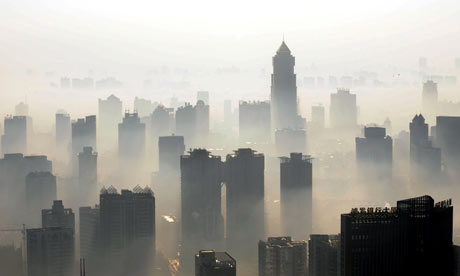We should all now be aware of the concept of climate change.
Not only has it become part of mainstream science but its claim to impending
global catastrophe has given the theory a very distinctive role in mainstream
politics. We have been taught that the increase in atmospheric CO2 produced
by man-made and natural causes has the potential to prevent solar energy from
escaping into space, resulting in higher global temperatures known as the
greenhouse effect. The theory of global warming is accepted worldwide;
encouraging businesses to take corporate responsibility for their carbon
emissions and has been a catalyst for international organisations such as the
Center for Climate and Energy Solutions. What we pay less attention to is the
other climate phenomenon that appears to be opposing the effects of Global
warming.
The particles released into the atmosphere from centuries of burning
coal, oil and wood have combined with water droplets in clouds; by acting
as a base the airborne particulates made up of soot, ash, and sulphur
compounds encourage more water droplets to form in clouds.
The clouds formed from the particle and water droplet
combination have been slowly reducing the amount of sun that reaches the
earth’s surface by reflecting solar rays back into space. This is happening at
a rate of roughly 2% every 10 years.
Global dimming was first discovered by Gerry Stanhill, an
English climate scientist carrying out research in Israel. Stanhill was
comparing Israel’s recordings of sunlight in the 1950s with more recent ones.
Stanhill found that there was a decrease in sunlight by 22%. He published his
research in 2001 but other climate scientists were sceptical of his results. It
was not until years later when a team of Australian scientists confirmed Stanhill’s
findings when they reached the same conclusions using a different method.
Experts in climate science have not been able to rule out
that natural weather variations have contributed to global dimming, but there
are strong correlations between the intensity of cloud cover and trends in
atmospheric pollution.
In some locations such as Lerwick, UK no dimming has been
recorded whereas continuous dimming has been observed in Hong Kong. Industrial
activity in the UK diminished a number of decades ago and the vast majority of
Industry relocated to countries like China and India.
Although the two climate processes have so far been apposing
each other. Global dimming is a danger to us. Anup Shah who writes
for Global Issues wrote “The pollutants that lead to global dimming also lead
to various human and environmental problems, such as smog, respiratory
problems, and acid rain.” The reflective clouds produced by global dimming
shield the oceans from the sun’s radiation, making waters in the northern hemisphere
much cooler. Cooler oceans mean less water evaporation and, in a cruel twist of
irony, the poor water evaporation generates a reduced amount of water vapour.
Global dimming may be disrupting global weather patterns and is likely
responsible for the 1970s and 80s African droughts which claimed hundreds of
thousands of lives.
"My main concern is global dimming is also having a
detrimental impact on the Asian monsoon . . . We are talking about billions of
people." Prof Veerhabhadran Ramanathan, one of the world's leading climate
scientists.
The dimming effect of increased cloud cover is likely to be
cancelling out a proportion of the greenhouse effect introduced by growing
global CO2 emissions. However as the international community
has encouraged the reduction of pollutants, the shielding effect of global
dimming will also be reduced and the planet may begin to observe the greatly
amplified effects of global warming. Many countries in Europe have taken
steps to reduce their pollutant producing emissions, but reducing air pollution
may have tipped the scale in Global warming’s favour and resulted in the 2003
European heatwave. The surge in temperatures created forest fires in Portugal
and killed thousands in France.
In short, the burning of fossil fuels and a geographical
shift and intensification of industrial activity has contributed to two
unstable environmental phenomenon; global warming and global dimming. The two
have mostly cancelled each other out, but if climate science and
international policy are to combat one they must combat both or we risk further
upsetting the balance and causing irreversible damage to the planet and our way
of life.
References
Clark, D (2012) What is Global Dimming?, The Guardian, accessed 15/08/2014 [Online] available from: http://www.theguardian.com/environment/2012/may/11/global-dimming-pollution
Conserve Energy Future (2014) What is Global Dimming?, accessed
15/08/2014 [Online] available from: http://www.conserve-energy-future.com/causes-and-effects-of-global-dimming.php
Haywood, J (2013) Global Dimming, Met
Office, accessed 15/08/2014 [Online] available from: http://www.metoffice.gov.uk/climate-change/guide/science/explained/dimming
Horizon (2005) Global Dimming, BBC,
accessed 15/08/2014 [Online] available from: http://www.bbc.co.uk/sn/tvradio/programmes/horizon/dimming_prog_summary.shtml
Shah, A (2005) Global Dimming, Global Issues, accessed 15/08/2014 [Online] available from: http://www.globalissues.org/article/529/global-dimming

No comments:
Post a Comment